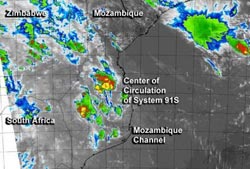NASA's Aqua satellite sees System 91S struggling

This false-colored infrared image from the MODIS instrument aboard NASA's Aqua satellite shows the strongest thunderstorms associated with System 91S to the west-northwest of the center over Mozambique.<br><br>Credit: NRL/NASA<br>
A false-colored infrared image was created at the Naval Research Laboratory in Washington, D.C. using infrared data from the MODIS instrument aboard NASA's Aqua satellite on January 31 at 11:05 UTC/6:05 a.m. EST.
The MODIS image showed the strongest thunderstorms associated with System 91S to the west-northwest of the center (over Mozambique), as a result of strong wind shear. Satellite data also revealed that the center of circulation is now elongated and that the strongest convection (rising air that forms the thunderstorms that make up a tropical cyclone) is occurring over the northwestern quadrant of the storm's center.
On January 31, System 91S had maximum sustained surface winds between 20 to 25 knots/37.0 to 46.3 kph/23.0 to 28.7 mph. Minimum sea level pressure was estimated to be near 1004 millibars.
Vertical wind shear continues to batter the tropical low, and the Joint Typhoon Warning Center expects the system to weaken as it moves south through the Mozambique Channel (between Mozambique on the African mainland and the island nation of Madagascar).
The Joint Typhoon Warning Center gives System 91S a low chance of development as it continues to deal with moderate to strong wind shear over the next couple of days.
Media Contact
More Information:
http://www.nasa.govAll latest news from the category: Earth Sciences
Earth Sciences (also referred to as Geosciences), which deals with basic issues surrounding our planet, plays a vital role in the area of energy and raw materials supply.
Earth Sciences comprises subjects such as geology, geography, geological informatics, paleontology, mineralogy, petrography, crystallography, geophysics, geodesy, glaciology, cartography, photogrammetry, meteorology and seismology, early-warning systems, earthquake research and polar research.
Newest articles

Red light therapy for repairing spinal cord injury passes milestone
Patients with spinal cord injury (SCI) could benefit from a future treatment to repair nerve connections using red and near-infrared light. The method, invented by scientists at the University of…

Insect research is revolutionized by technology
New technologies can revolutionise insect research and environmental monitoring. By using DNA, images, sounds and flight patterns analysed by AI, it’s possible to gain new insights into the world of…

X-ray satellite XMM-newton sees ‘space clover’ in a new light
Astronomers have discovered enormous circular radio features of unknown origin around some galaxies. Now, new observations of one dubbed the Cloverleaf suggest it was created by clashing groups of galaxies….





















